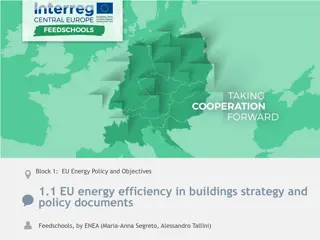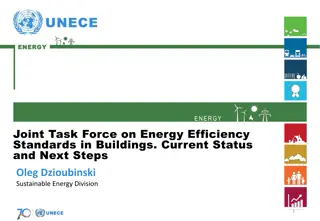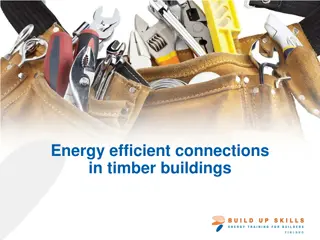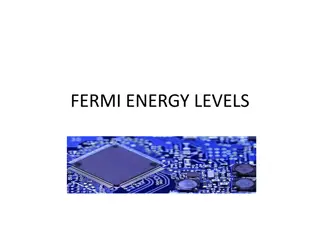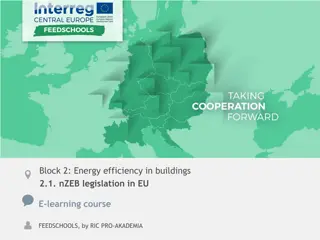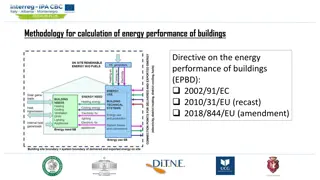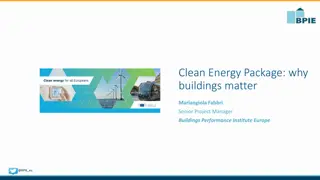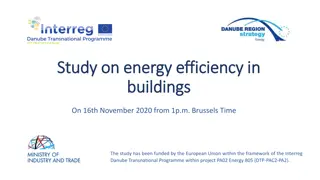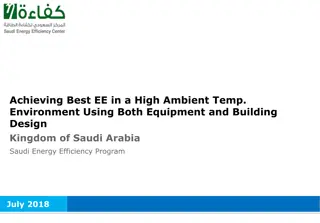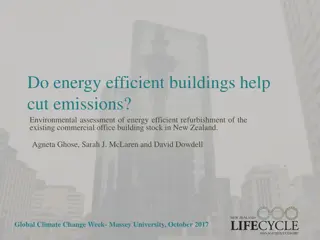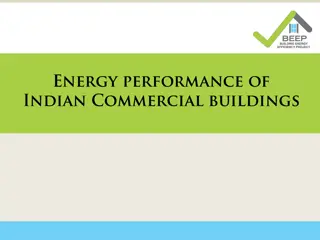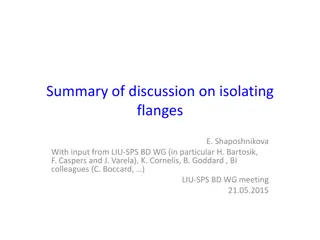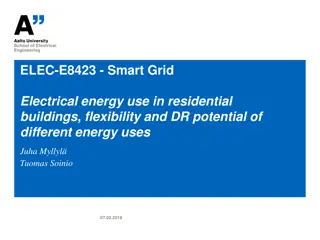Understanding Insulating Materials for Energy Efficient Buildings
Insulating materials play a crucial role in maintaining energy efficiency in buildings. This presentation covers the classification of insulating materials based on solid structure nature - mineral, vegetal, and synthetic. It explores the properties and applications of different types of insulating materials, such as cork, glass fibers, perlite, and more. Understanding the characteristics and thermal conductivity of these materials is essential for enhancing energy efficiency in construction.
Download Presentation

Please find below an Image/Link to download the presentation.
The content on the website is provided AS IS for your information and personal use only. It may not be sold, licensed, or shared on other websites without obtaining consent from the author. Download presentation by click this link. If you encounter any issues during the download, it is possible that the publisher has removed the file from their server.
E N D
Presentation Transcript
Dipartimento di Ingegneria Industriale e dell Informazione via Roma 29, 81031 Aversa, Italy MARUEEB project 561890-EPP-1-2015-1-IT-EPPKA2-CBHE-JP MASTER DEGREEIN INNOVATIVETECHNOLOGIESIN ENERGY EFFICIENT BUILDINGSFOR RUSSIAN & ARMENIAN UNIVERSITIESAND STAKEHOLDERS Insulating Materials Speaker: Oronzio Manca
INSULATING MATERIALS There are no clear definitions. Typically this concept is linked to a low value. Cork: first material used in construction as insulation. The thermal conductivity of a material decreases with increasing its porosity.
INSULATING MATERIALS No interconnected pores Interconnected pores The decrease of is attenuated by the presence of convective phenomena In rest conditions the dry air thermal conductivity is much lower than that of any solid matrix
CLASSIFICATION With reference to the nature of the solid structure Mineral insulating: they result from technological processes that have as a basic component a mineral or a mineral rock Mineral insulating Vegetal insulating Synthetic insulating
CLASSIFICATION With reference to the nature of the solid structure Vegetal insulating: they have as a basic component a vegetal material with a variety of processes depending on the raw material used Mineral insulating Vegetal insulating Synthetic insulating
CLASSIFICATION With reference to the nature of the solid structure Synthetic insulating: are high molecular weight materials obtained by synthesis of organic compounds with low molecular weight Mineral insulating Vegetal insulating Synthetic insulating
CLASSIFICATION With reference to the nature of the solid structure Mineral insulating: glass fibers, perlite, vermiculite, foamed clay, ... Vegetal insulating: panels made of wood fibers, cork, cellulose, ... Synthetic insulating: plastic materials, synthetic resins, ...
CLASSIFICATION Synthetic organic polymers Thermoplastic resins Thermosetting resins An increase in temperature makes the material fluid while cooling restores the previous state First they soften with increasing temperature, becoming fluid, and then harden irreversibly
CLASSIFICATION Synthetic organic polymers Thermoplastic resins Thermosetting resins Expanded or extruded polystyrene, extruded polyethylene, polyester resins, ... Phenolic resins, urea resins, polyurethanes, ...
SELECTION CRITERIA Thermal conductivity Vapor permeability Resistance to chemical and biological agents Fire behavior Mechanical resistance Stability of the material Absorption coefficient to water
THERMAL CONDUCTIVITY Ability of a material, homogeneous and isotropic, to transfer thermal energy when the transmission occurs only by conduction It varies with the temperature but, as in the building structures the range of operating conditions is restricted, this parameter is assumed constant
THERMAL CONDUCTIVITY Cellular materials, granular materials, fibrous or porous materials with low density values The measured values of increase with both the thickness of the material and the imposed thermal gradients In the absence of convection, in operating conditions, tends to a constant value with the increase of the thickness (> 10cm)
THERMAL CONDUCTIVITY UNI-10351/94 Dummy a Reference value m Value of thermal conductivity that the material would have if it were homogeneous and isotropic on the assumption that the heat flow is only conductive The upper limit of dummy thermal conductivity measured or measurable in the conditions imposed by legislation
THERMAL CONDUCTIVITY UNI-10351/94 The apparent thermal conductivity ais to be measured: on thick samples greater than or equal to 10 cm at the average temperature of 20 C with T between the two faces of the specimen greater than 15 C with a humidity percentage by mass less than 2% after the test on inorganic materials
THERMAL CONDUCTIVITY Norma UNI-10351/94 The aand mvalues cannot be hired in the civil structural design because they are obtained in "controlled environments UNI-10351/94 introduces a mark-up m
THERMAL CONDUCTIVITY m depends on: type of material percentage content of moisture aging of the material compaction in the case of bulk materials thickness tolerances when this is not less than 10 cm
THERMAL CONDUCTIVITY m m = increase of the reference conductivity m (1+m) = material conductivity usable for calculation to be used in the design procedures and thermal verification
THERMAL CONDUCTIVITY Insulating materials There is a very close link between and In general: is lower the higher is the fraction of air volume This is true since the value of the order of 20-30 kg/m3
THERMAL CONDUCTIVITY Insulating materials With the same density is lower the greater the ratio between the number of no interconnected pores (closed cells) compared to those interconnected (open cells)
THERMAL CONDUCTANCE = C s THERMAL RESISTANCE s = R
VAPOR PERMEABILITY Ability of a material to vapor diffusion and depends on the chemical composition, structure and porosity of the material It varies with the temperature and pressure but, given the small variation that these properties have in the building field, this parameter is assumed constant
VAPOR PERMEABILITY UNI-10351/94 It provides the values of vapor permeability determined with tests conducted at constant temperature in the range of relative humidity between 0% and 50% Vapor permeability in dry field a kg/(s m Pa)
VAPOR PERMEABILITY UNI-10351/94 The hygrometric behavior of the material in work can be significantly different from that of laboratory UNI-10351/94 provides the values of vapor permeability in moist field u
VAPOR PERMEABILITY UNI-10351/94 For several materials the data relating to vapor permeability are limited and uncertain UNI-10351/94 provides a unique value of permeability preceded by the sign
PERMEANCE = W s RESISTANCE TO VAPOR DIFFUSION s = Z
VAPOR PERMEABILITY Relative Permeability Ratio between the vapor permeability of air at rest and the vapor permeability of the material = aria
RESISTANCE TO CHEMICAL AND BIOLOGICAL AGENTS It is important to know for each insulating material which are substances that can attack it chemically It is necessary to verify the behavior of the material under the action of biological agents
FIRE BEHAVIOUR Under current rules, the buildings are divided into classes, depending on the extent of the fire hazard The class indicates, in minutes, the minimum period of the fire resistance of the structures or components
FIRE BEHAVIOUR The fire behavior of a material must be evaluated not only according to the intrinsic characteristics of the material itself, but also in function of: its position in the element structure the fire behavior of the other materials constituting the structural element the type of building the building's target
FIRE BEHAVIOUR Fire resistance Attitude of an element to preserve the characteristics of stability R, retaining E and heat insulation I The E It is expressed in minutes
FIRE BEHAVIOUR Fire resistance R: ability to retain the mechanical strength under the fire action E: ability to not let pass or produce flames, vapors or hot gases
FIRE BEHAVIOUR Fire reaction Level of participation of a combustible material to a fire to which it is subjected It describes the behavior of the material during the ignition phase and its spread
MECHANICAL RESISTANCE The mechanical properties are those which the material manifests under the action of a load The compressive resistance of the insulating material takes on particular importance in the case of insulation of horizontal structures
MECHANICAL RESISTANCE Compressive resistance The unit load value which causes the breakage of a regular geometric shape specimen, subjected to a normal compressive stress with free lateral expansion It increases with increasing density
DIMENSIONAL STABILITY Most of the thermal insulators is produced with technologies that use cooking ovens or exothermic reactions The cooling can cause a reduction in size, which is particularly strong in the first successive times to the production
DIMENSIONAL STABILITY This shrinkage increases with increasing density of the material The regulation establishes the conditions under which the tests shall be performed
WATER ABSORPTION Capacity of the material to be imbibed with water This characteristic is evaluated by the percentage change in volume of a series of specimens to a predetermined temperature after they have been immersed in water for an established period of time
MINERAL INSULATING Glass Fiber a u Use m % c [kg/m3] W/mK 10-12kg/(s m Pa) kJ/(kg K) 10-12kg/(s m Pa) 150 150 Felts 11 14 16 16 20 30 100 10 0.046 0.048 0.053 0.046 0.043 0.040 0.038 0.84 150 150 Semi-rigid panels 10 0.84 150 150 Rigid panels 10 0.84
VEGETABLE INSULATING Cork panels a u Use m % c [kg/m3] W/mK 10-12kg/(s m Pa) kJ/(kg K) 10-12kg/(s m Pa) Pure expanded (Humidity 2-4%) Expanded with binders (Humidity 2-4%) 130 10 0.045 6.7-10.0 2.1 6.7-10.0 90 130 200 10 0.043 0.045 0.052 6.7-10.0 4.0-21.0 4.0-21.0 2.1 2.1 2.1 6.7-10.0 4.0-21.0 4.0-21.0
SYNTHETIC INSULATING Polyethylene a u Use m % c [kg/m3] W/mK 10-12kg/(s m Pa) kJ/(kg K) 10-12kg/(s m Pa) Extruded, without netting 30 50 20 0.050 0.060 0.938 2.1 / netting extruded 33 50 20 0.048 0.058 0.938 2.1 /
Type of substance Thermal Conductivity Gas 10-2 10-1 Liquid 10-1 1 Non metal solids 1 10 Metal solids 10 102






